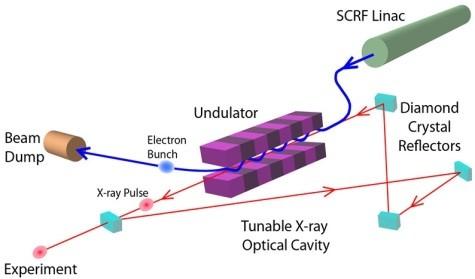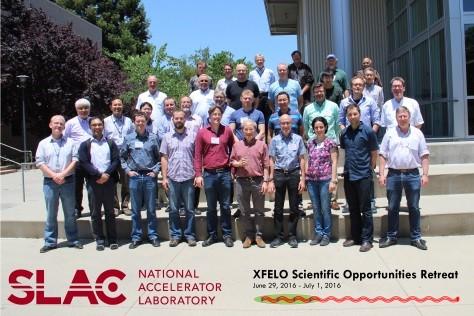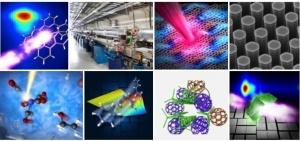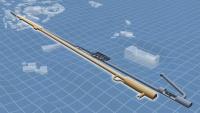LCLS-II-HE Meetings and Reports
The science needs for the capabilities of LCLS-II-HE have been developed by the international science community over many years. Following are some of the key workshops organized by SLAC that have driven the development of the science case. Since the original proposal for LCLS-II-HE, we have continued to advance and refine the science opportunities, initially through a series of “First Experiments” Meetings hosted at SLAC in 2017, followed by a workshop on advanced methods and instrumentation for LCLS-II-HE science hosted at SLAC in 2018. Some of the most recent dedicated workshops focused on: (1) science opportunities for the dynamic X-ray scattering (DXS) Instrument at LCLS-II-HE in 2021 and 2022, (2) non-linear multidimensional methodologies for studying chemical sciences in 2020, and (3) applications of ultrafast X-ray science to grand challenge questions in gas phase chemical reactions in 2020.
Science Opportunities for the Dynamic X-ray Scattering (DXS) Instrument at LCLS-II-HE
November 17, 2021 Virtual Workshop (SLAC National Accelerator Laboratory)
LCLS-II-HE Science Opportunities for the DXS Instrument Workshop, November 17, 2021
June 8, 2022 Virtual Workshop (SLAC National Accelerator Laboratory)
LCLS-II-HE Science Opportunities for the DXS Instrument Workshop, June 8, 2022
The objective of this workshop series is to refine the scientific drivers for the DXS instrument, particularly high-impact science areas that can exploit the high-resolution IXS capabilities and the cross over between IXS and XPCS techniques. IXS has traditionally been a synchrotron-based technique since the average spectral flux of the existing FEL sources had been inadequate for these low-count experiments. Therefore, there strong interest for engagement between the ultrafast materials sciences and IXS communities. One of the awaited outcomes of this workshop is to bring these two communities together and deliberate potential avenues to explore. Additionally, we expect to discuss and improve the instrument parameters answering to the desires of the community, including pump and probe beam characteristics, and sample environment capabilities.
Opportunities & challenges of cavity-based X-ray free-electron lasers
March 24-26, 2021 Virtual Workshop
Opportunities & challenges of cavity-based X-ray free-electron lasers Workshop, March 24-16, 2021
Cavity-Based Free-Electron Lasers (CBXFELs) promise true laser-like radiation properties in the X-ray regime. In addition to an XFEL Oscillator (XFELO) driven by a linear accelerator, an XFELO driven by, and integrated into, a low-emittance storage ring was proposed. A potentially less challenging but broader bandwidth CBXFEL is the Regenerative Amplifier (RAFEL) driven by an electron accelerator. This international workshop brings together experts in areas related to the construction of CBXFELs (meaning the accelerator and various X-ray instrumentation areas), scientists with expertise in the development and application of various X-ray techniques, as well as scientists from potential scientific application areas.
Non-Linear Multidimensional Methodologies for Studying Chemical Sciences
December 9-10, 2020 Virtual Workshop (SLAC National Accelerator Laboratory)
Non-Linear Multidimensional Methodologies for Chemical Sciences Workshop, Dec. 9-10, 2020
The LCLS will resume User operations in fall 2020, and in the near future the LCLS-II and LCLS-II-HE upgrades will scale to MHz X-ray repetition rates. The continuous energy tunability, multi-color capabilities, and orders-of-magnitude fluence increase, compared to other sources of X-rays, will enable a variety of new, differential, multi-dimensional investigations. This workshop will focus on innovative opportunities this new source will create in chemical sciences. The goal of the virtual workshop is to exchange ideas to determine impactful, new scientific avenues using the LCLS-II and LCLS-II-HE, and to foster new collaborations in chemical sciences
Applications of Ultrafast X-ray Science to Grand Challenge Questions in Gas Phase Chemical Reactions
February 10, 2020 SLAC National Accelerator Laboratory
Applications of Ultrafast X-ray Science to Gas Phase Chemical Reactions Workshop, Feb. 10, 2020
The SLAC Chemical Science Division hosted a workshop with the aim to identify Priority Research Directions (PRD) at the interface between ultrafast X-ray science and gas phase chemical physics. X-ray laser science will be transformed with the LCLS-II and LCLS-II-HE upgrades, making this an opportune time to identify, plan, and pursue PRD in gas phase chemical physics at LCLS.
The workshop had two key objectives. First, to facilitate the establishment of relationships between the principal investigators in the Gas Phase Chemical Physics (GPCP) program and scientists at LCLS and SLAC. The second goal was to identify areas where ultrafast X-ray laser science is poised to advance PRD in the GPCP program. The workshop and report identifies areas for advancing our understanding of ultrafast chemistry, as well as developmental opportunities to advance our understanding of reaction pathways in diverse environments.
Advanced X-ray Methods & Instrumentation for LCLS-II-HE Science
October 16-17, 2018
SLAC National Accelerator Laboratory
The objective of this workshop is to further engage the science community in helping to identify the most compelling X-ray methods and instrumentation that will exploit the unique capabilities of LCLS-II-HE for the greatest scientific impact. The results of this workshop will help guide the design, performance capabilities, and priorities for new future scientific instrumentation for LCLS-II-HE.
LCLS-II-HE “First Experiments” Meetings: AMO, Biology, and Quantum Materials
October 30-31, 2017
SLAC National Accelerator Laboratory
The objective of these three parallel workshops is to convene working groups to further develop the science case for the proposed energy upgrade of LCLS-II (LCLS-II-HE) in the following areas:
AMO and Gas-Phase Chemistry:
- Fundamental molecular dynamics
- Strong-field physics
- Chemical-dynamics (imaging/scattering)
Biological Function and Structural Dynamics:
- Spontaneous (stochastic) dynamics and conformational heterogeneity
- Triggered dynamics - pump/probe, rapid mixing
- Advanced algorithms to provide new insight to biological function
Quantum Materials:
- Correlated Materials
- Low-dimensional Materials and Heterostructures
- Exotic magnetism and spin phenomena
LCLS-II-HE will provide X-ray energies extending beyond 12 keV to enable high repetition-rate studies of atomic, electronic, and chemical dynamics at the atomic scale. The near-term goal of these workshops is to define a series of “first experiments” that illustrate the most important science challenges that can be uniquely addressed by LCLS-II-HE. These will further guide the development of instrumentation and related plans for the upgraded facility.
LCLS-II-HE “First Experiments” Meetings: Chemistry & Materials Physics
July 20-21, 2017
SLAC National Accelerator Laboratory
The objective of these two parallel workshops is to convene working groups to further develop the science case for the proposed energy upgrade of LCLS-II (LCLS-II-HE) in the following areas:
Chemistry:
- Chemical dynamics, coordination- and photo-chemistry
- Photo-catalysis, natural and artificial photosynthesis
- Catalysis and environmental chemistry
Material Physics:
- Photo-induced phase transitions, nonequilibrium dynamics, low-dimensional materials
- Stochastic phenomena, fluctuations, heterogeneity
- High energy density science
LCLS-II-HE will provide X-ray energies extending beyond 12 keV to enable high repetition-rate studies of atomic, electronic, and chemical dynamics at the atomic scale. The near-term goal of these workshops is to define a series of “first experiments” that illustrate the most important science challenges that can be uniquely addressed by LCLS-II-HE. These will further guide the development of instrumentation and related plans for the upgraded facility.
Scientific Opportunities for Ultrafast Hard X-rays at High Repetition Rate: An Energy Upgrade of LCLS-II
September 26-27, 2016
SLAC National Accelerator Laboratory

The proposed energy upgrade of LCLS-II to 8 GeV (LCLS-II-HE) promises to open entirely new areas of science by providing X-ray energies extending beyond 12 keV to enable high repetition-rate studies of atomic, electronic, and chemical dynamics at the atomic scale.
The objective of this workshop is to further develop the science case for this proposed upgrade, and refine the technical requirements to ensure maximum scientific impact. The results of this workshop will help guide the design and performance capabilities of the upgraded facility; and will inform the planning for new future scientific instrumentation. More than 160 participants from around the world attended this workshop and contributed to the science drivers that were captured in the LCLS-II-HE CD-0 proposal.
Previous SLAC workshops informing LCLS-II-HE science:
XFELO Science Workshop
June 29-July 1, 2016
SLAC National Accelerator Laboratory

This workshop comprised two and half days of in-depth discussion from international participants of various scientific opportunities that might be enabled by an XFEL oscillator (XFELO). The scientific discussion also provided valuable input for developing the science case for extending the performance of LCLS-II into the hard X-ray range (LCLS-II-HE) as there is significant overlap in capabilities with XFELO.

High-gain free electron lasers at the LCLS at SLAC and other laboratories around the world have demonstrated the power of FELs for X-rays. An oscillator-type FEL is also feasible for the hard X-ray spectral region producing fully coherent, intense X-ray pulses of high spectral purity with MHz repetition rate. It appears that an XFELO is within the reach of current technology and, furthermore, the 4 GeV CW-SCRF linac under construction for the LCLS-II is a suitable driver a practical XFELO.
Research Opportunities in Photochemistry, Solar Energy
& Advanced X-ray Methods
June 16-17, 2016
SLAC National Accelerator Laboratory

This workshop was jointly organized by LCLS and SSRL and focused on fundamental questions in solar energy conversion and opportunities where advanced X-ray methods will have a significant impact. The workshop goals were to: (i) facilitate the exchange of ideas and foster collaborations between scientists focused on solar energy conversion and researchers with expertise in time-resolved X-ray science, (ii) identify challenges and opportunities for time-resolved X-ray methods for addressing problems in basic energy science, and (iii) propose development paths for the most compelling science areas. More than 140 participants attended, and there were three breakout sessions on:
- Nano- and solid state materials for solar energy conversion
- Molecular materials for solar energy conversion
- Fundamental chemistry and physics of light driven phenomena
These discussions identified a number of important scientific opportunities in the areas of photochemistry and molecular energy capture requiring the unique capabilities of both LCLS-II and LCLS-II-HE.
LCLS-II Scientific Opportunities Workshops
February 9-13, 2015
SLAC National Accelerator Laboratory

The LCLS-II Scientific Opportunities Workshop series was organized to advance the scientific opportunities of this new facility, and refine the technical requirements to ensure maximum impact during early operations and into the future. The series comprised four sequential meetings focused on: Materials Physics, Life Sciences, Chemistry, and Materials in Extreme Conditions. More than 400 participants from around the world attended these workshops and contributed to the workshop report. The results of these workshops feed directly in to the science strategy for LCLS-II; to help guide the design, commissioning and ultimate operation of the upgraded facility; and further inform the R&D roadmap for instrumentation and machine performance.
While the focus of the meeting was on science drivers for the soft and tender X-ray range of LCLS-II, there was also significant discussion of science needs for extending the high-repetition-rate performance in to the hard X-ray range.
LCLS-II New Instruments Workshop
March 19-22, 2012
SLAC National Accelerator Laboratory

The goal of the original LCLS-II workshops was to identify the most exciting science and corresponding parameters which to help define the LCLS-II instrumentation. Scientists from around the world provided short descriptions of the scientific opportunities they envision at LCLS-II. The workshops focused on four broadly defined science areas: biology, materials sciences, chemistry and atomic, molecular and optical physics (AMO).
